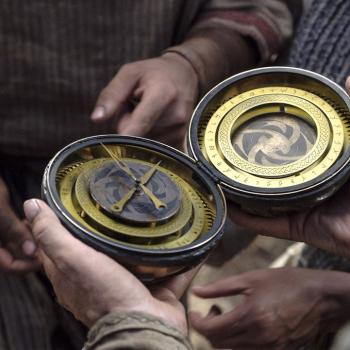
As, according to credible reports, the Interpreter Foundation continues to fade and its website and journal continue to stagnate, here are four new articles that have just appeared:
“LDS Perspectives on the Atonement?” written by Blake T. Ostler
Review of Deidre Nicole Green and Eric D. Huntsman, eds., Latter-day Saint Perspectives on Atonement (Urbana: University of Illinois Press, 2024). 344 pages, $35.00 (paperback).
Abstract: Latter-day Saint Perspectives on Atonement promises to provide new perspectives on the atonement that reflect awareness of scriptural and theological scholarship. The essays on the scriptural background are solid. The essays providing theological perspectives are uneven, at best. Indeed, the theological essays show little awareness of the major works in philosophical theology in the last sixty years—with one notable exception. Moreover, a feminist perspective that argues against seeing Christ’s blood that he shed as an appropriate basis for atonement theory receives the greatest attention. This review elucidates, explores, assesses, and critiques these approaches.
“Nameless: Mormon’s Dramatic Use of Omission in Helaman 2,” written by Nathan J. Arp
Abstract: There are many reasons why a narrator may choose to provide or withhold the names of various characters. This article hypothesizes that Mormon intentionally omitted the name of a key character from the book of Helaman related to the origin of the Gaddianton robbers. While it is not possible to know exactly what information Mormon and other Nephite recordkeepers had or preserved, it is at least plausible that Mormon might have intentionally omitted the name of a clandestine operative in the first two chapters of Helaman as a specific strategy to emphasize this operative’s secrecy and allow the reader to take on his identity more easily. By using this narrative strategy, Mormon can powerfully demonstrate to the reader the importance of resisting tyranny in the defense of freedom. Moreover, Mormon thrills his readers with a tale of spy vs. spy: the Gaddianton robbers versus the nameless organization that initially defeats them. This article suggests that Mormon is a careful editor capable of the rare literary magic of revealing hidden truths that can best be said through silence.
“Interpreting Interpreter: Helaman’s Secret Service,” written by Kyler Rasmussen
This post is a summary of the article “Nameless: Mormon’s Dramatic Use of Omission in Helaman 2” by Nathan J. Arp in Volume 62 of Interpreter: A Journal of Latter-day Saint Faith and Scholarship. All of the Interpreting Interpreter articles may be seen at https://interpreterfoundation.org/category/summaries/. An introduction to the Interpreting Interpreterseries is available at https://interpreterfoundation.org/interpreting-interpreter-on-abstracting-thought/.
[Author’s Note: Hey everyone! This happens to mark the 100th summary I’ve done for Interpreter. I’ve been trying to think of a way to celebrate, and the best thing that comes to mind is hearing from you! If you’ve been getting value out of these, please leave a comment below.]
The Takeaway: Arp proposes that Mormon deliberately withheld the name of Helaman’s servant, as well as details of the potential comrades (termed by Arp as the “Secret Service”) that may have assisted him in opposing the Gadianton Robbers. This silence could have fit the themes of visibility/invisibility in the narrative, or allowed readers to more easily identify themselves with these unnamed heroes.
Hugh Nibley Observed: “Joseph or Jung?” written by my late and much-missed friend William J. Hamblin, one of the co-founders of the Interpreter Foundation
“Nibley treats Mormon scripture primarily through parallels. While we need not pay any attention to those shallow critics of Nibley who merely shout “Parallelomania,” as if it were a magical incantation, and reject his whole methodology and corpus out of hand (drawing parallels is a necessary technique for any scholar; one must simply judge each parallel separately to see what validity it offers—and many of Nibley’s parallels are convincing and valuable, while others are less persuasive or informative)— this technique requires careful analysis of the passages to be compared.”

Again, I invite you to watch any or all of this new series of video shorts that is being created by the moribund and comatose Interpreter Foundation — and, if you feel so inclined, to share them, whether as a group (that is not yet complete) or individually and incrementally.

(Wikimedia CC public domain photo)
This is a poignant column from one of the most interesting sociologists of religion in the United States, who has until now, melded a career as a professor and an academic sociologist with ministry as a Protestant pastor: “My church is closing, and I don’t know what comes next — for me, or America: I researched the decline of organized religion while having a front-row view of the change in my own life”
I don’t think that prayers for Pastor Burge (Dr. Burge) would be amiss. My impression of him, from reading his writing over several years, is that he is not only a bright and insightful student of the current scene but a good and dedicated disciple of the Lord Jesus Christ. I hope that his faith will not only survive but flourish, and that he will find a way forward.

I’m not sure when it was that my Malevolent Stalker went public with his odd fixation on me — roughly fifteen or twenty years ago, I think — but he’s still going strong. In the past few days, he’s been informing his audience there that I’m out of favor with the folks at FAIR LDS and at Scripture Central. He’s probably right, of course. (It has to happen sometime, after all. You’re familiar with the proverb about even stopped clocks being right twice a day.)
But I’m curious about exactly when it happened. The leadership of Scripture Central didn’t seem to have turned up its nose at me back in April when it had me travel to New York and Pennsylvania and Ohio to help film one of the segments of its series A Marvelous Work, nor in June when it released the video that resulted, nor a few days ago when I last spoke with Scripture Central’s director. And it doesn’t seem to have occurred in June, when FAIR LDS had me speaking at its conferences over in Italy and Austria and Sweden — a venture about which the Stalker complained and mocked with great dedication.
By the way, I will be speaking at the 2024 annual FAIR conference, which will be held on Thursday, 8 August, and Friday, 9 August, at the American Heritage School in Salt Lake City. For questions about ticketing, sponsorship opportunities, or other details, please contact the good folks at conference@fairlatterdaysaints.org.

(Wikimedia Commons public domain photo)
And finally, as is my wont, I close with a horror that I’ve drawn for the anti-theistic gratification of some of my more dedicated readers from the Christopher Hitchens Memorial “How Religion Poisons Everything” File™: “Church joins Miller and Walker funds in multimillion-dollar donation to reduce homelessness: Money will help Salt Lake City housing project expand as part of an effort to provide comprehensive services that lift people out of poverty”
Posted from Newport Beach, California

















